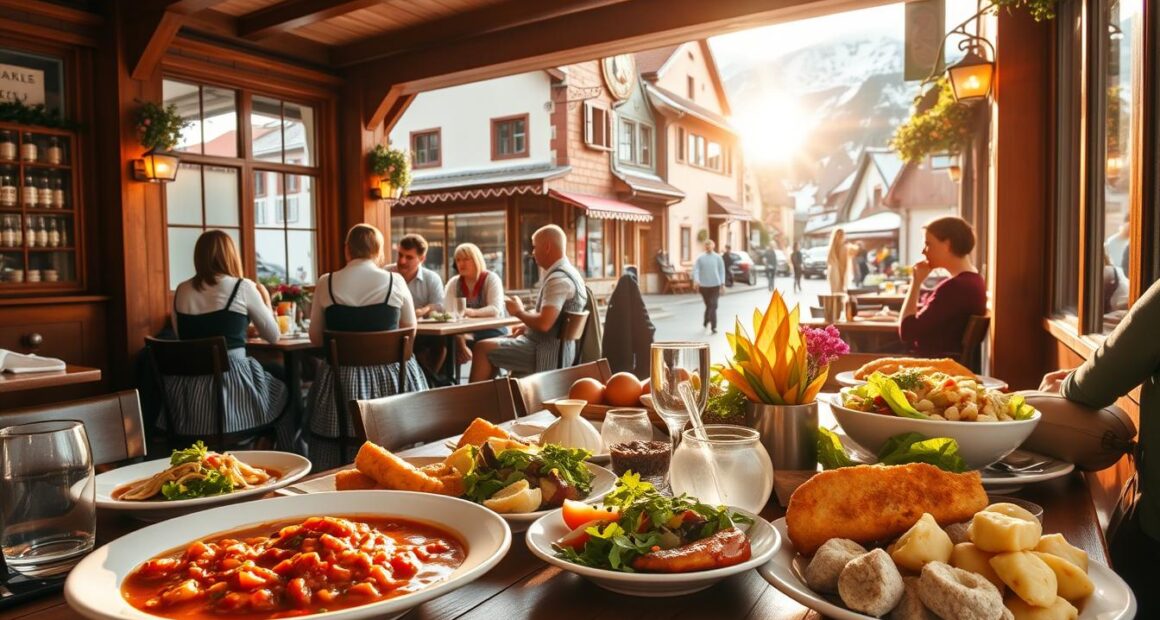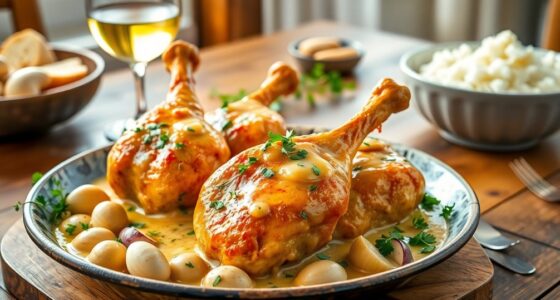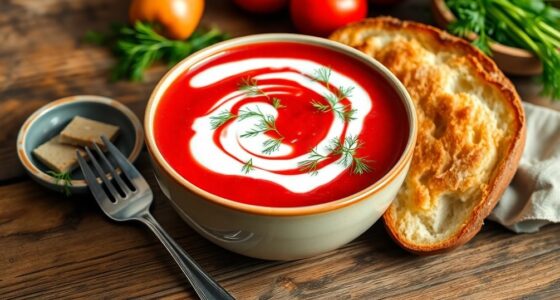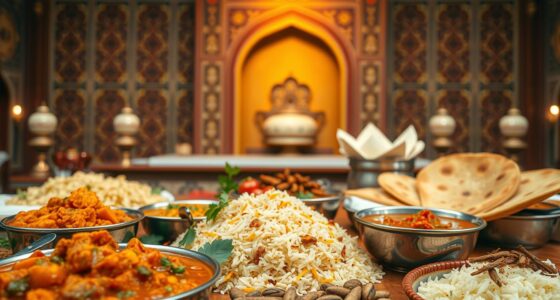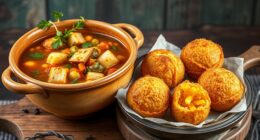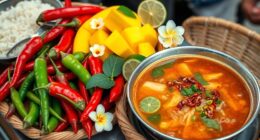Imagine walking through the picturesque streets of Vienna, the aroma of freshly baked goods wafting through the air, beckoning you to indulge in the rich tapestry of flavors that is Austrian cuisine. Each meal tells a story, merging traditions passed down through generations with local ingredients that reflect the vivid seasonal changes of the Central European landscape. As you savor a plate of Wiener Schnitzel or delight in the sweetness of Apfelstrudel, a sense of belonging and nostalgia wraps around you, connecting you to a culture that cherishes gatherings over good food. Embracing this cuisine is more than just tasting traditional Austrian dishes; it is about experiencing the warmth of life’s simple pleasures. Whether you are planning a trip to the scenic Salzkammergut region or trying to recreate these flavors in your own kitchen, the charm of Austrian cooking invites you to discover the heart of its culinary heritage.
As you embark on this culinary journey, let’s explore the essentials that make Austrian cuisine unique, from historical influences to key ingredients that embody its spirit. It is a celebration that awaits in the best Austrian restaurants, where the classics come alive, and memories are made one bite at a time.
Key Takeaways
- Austrian cuisine blends hearty comfort food with refined culinary traditions.
- Iconic dishes like Wiener Schnitzel and Apfelstrudel define traditional Austrian offerings.
- The use of seasonal and local ingredients enriches the taste of Austrian dishes.
- Austria’s coffee culture has deep historical roots, adding to its culinary charm.
- Exploring regional varieties reveals a diverse landscape of flavors in Austrian cuisine.
Introduction to Austrian Cuisine
Austrian cuisine offers a rich tapestry of flavors and dishes influenced by its geographical location and historical context. Originating from a blend of various regional practices, Austrian cuisine history reflects the impact of neighboring countries such as Hungary, Germany, and Italy. You will discover how these influences come together to create a unique food culture showcasing austrians culinary traditions.
Historical Influences on Austrian Cuisine
The culinary landscape of Austria emerged significantly during the era of the Austro-Hungarian Empire, where culinary exchange led to a wealth of diverse dishes. The predominant Viennese cuisine showcases this fusion, where local ingredients meet international cooking methods. Recognition of the diverse backgrounds has allowed traditional foods to flourish, with dishes such as Wiener Schnitzel epitomizing this union. This iconic dish, traditionally crafted from veal, underscores the prominence of meat in Austrian meals, demonstrating the country’s fondness for quality ingredients.
Key Ingredients in Austrian Cooking
Key ingredients in Austrian cooking encompass a variety of meats, specifically pork and beef, along with dairy and seasonal vegetables. Austria’s rich soil and local farming practices result in an abundance of fresh produce and edible herbs. Typical meals often include sausage varieties like Frankfurter and Käsekrainer, enhancing the meat-centric aspect of the diet. Apples and tomatoes are two of the most consumed vegetables in Austria, highlighting their emphasis on fresh, local flavors. Additionally, Austrian cuisine features incredible dairy products, with various cheeses taking center stage. You might enjoy traditional desserts, including the famous Sachertorte, or delve into the coffee culture that thrives in Vienna’s coffee houses. Understanding the essential elements that constitute Austrian cuisine brings to light the rich tapestry of this nation’s culinary art.
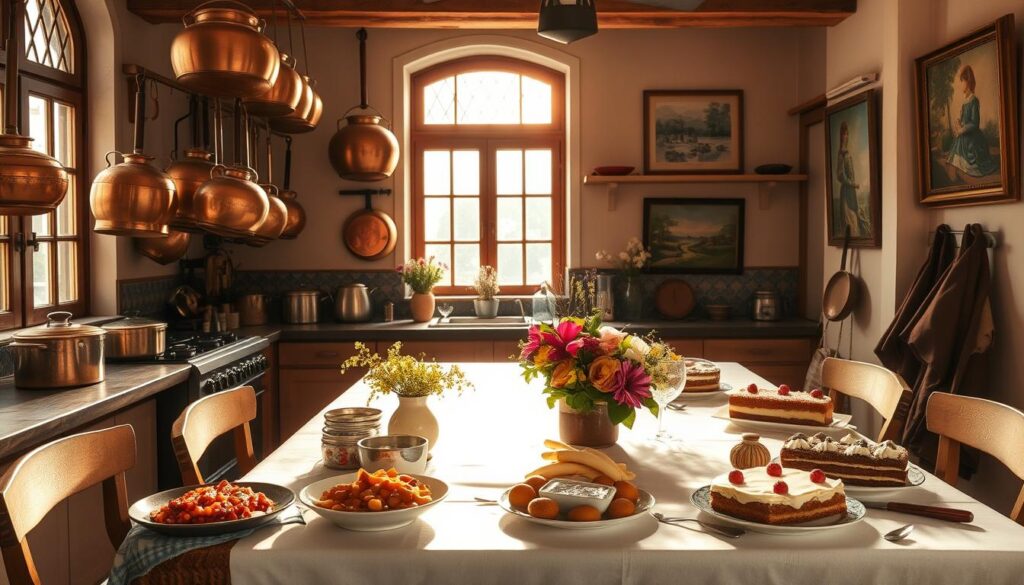
Traditional Austrian Dishes You Should Try
Austrian cuisine is a treasure trove of flavors and traditions, showcasing a variety of delightful dishes you simply must experience. Among the well-known traditional Austrian dishes, several stand out as iconic representations of the country’s culinary heritage. Each dish tells a story and invites you to explore the flavors of Austria.
Wiener Schnitzel: The Iconic Dish
The Wiener Schnitzel is perhaps the most famous of all traditional Austrian dishes. This dish consists of crispy breaded veal cutlets, pan-fried to golden perfection. The tenderness of the meat combined with a light, crunchy coating creates an irresistible experience. With its popularity extending across many of Europe’s best foodie cities, Wienerschnitzel remains a beloved classic for both locals and visitors alike.
Tafelspitz: A Royal Delight
Tafelspitz holds a special place in Austrian culinary culture, having been a dish favored by royalty. This comforting meal features boiled beef simmered in flavorful broth, accompanied by root vegetables and often served with traditional sides. The harmonious blend of flavors makes Tafelspitz not just a meal, but an enduring symbol of Austrian gastronomy.
Apfelstrudel: A Sweet Finish
No exploration of traditional Austrian dishes would be complete without sampling Apfelstrudel. This exquisite pastry showcases spiced apple filling enveloped in paper-thin dough, often enjoyed warm and dusted with powdered sugar. Its rich history reflects centuries of culinary craftsmanship, making Apfelstrudel a must-try treat that encapsulates the sweetness of Austrian desserts.
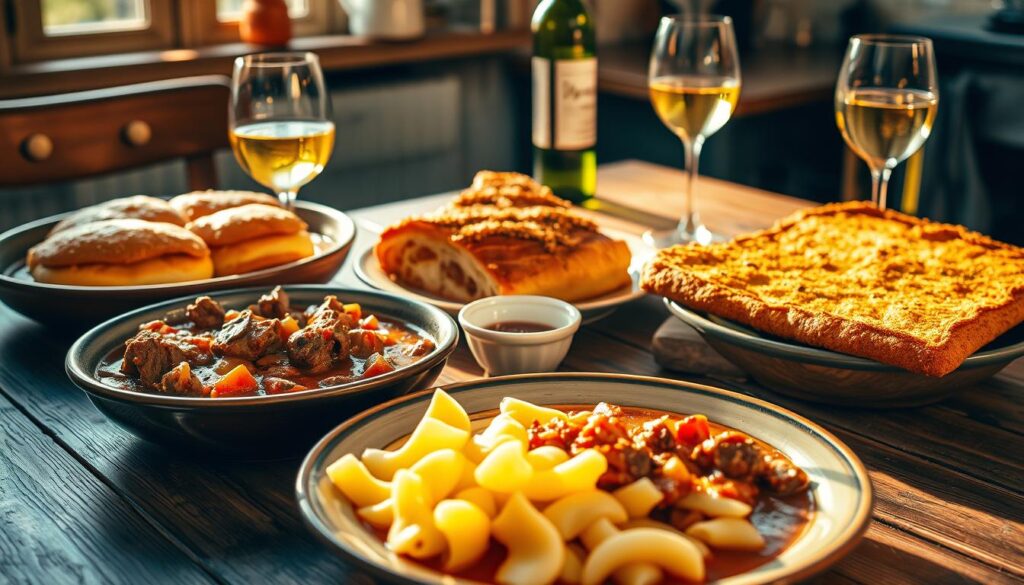
Understanding Austrian Food Culture
Austrian food culture is deeply rooted in traditions that emphasize togetherness and community. Family meals play a crucial role, bringing loved ones together to share not only food but also stories and experiences. The rituals surrounding meal preparation and enjoyment enhance these gatherings, ensuring that the flavors and recipes are passed down through generations. At the same time, the cultural landscape is vibrant with celebrations that highlight the country’s rich culinary offerings. Austrian festivals showcase local specialties and foster a sense of community pride.
Importance of Family Meals
In Austrian households, family meals are not merely about sustenance; they symbolize unity and continuity. Traditional dishes like Tafelspitz or Knödel often grace the table, formed through recipes cherished over the years. Breakfast usually includes fresh bread, jam, and a selection of cold meats and cheeses, setting the tone for a shared day. Meals are typically enjoyed at specific times, with lunch serving as the main meal, transitioning to dinner later in the day. This routine brings families closer together, creating lasting bonds.
Feasting During Festivals
Austrian festivals serve as a delightful celebration of local cuisine, showcasing food that reflects the country’s cultural diversity. Christmas markets are particularly famous for their seasonal specialties, where you can savor delicacies like Apfelstrudel alongside warming beverages. These events not only promote local food culture but also strengthen community ties. Throughout the calendar year, various festivals allow you to indulge in exquisite flavors while celebrating Austria’s rich heritage.
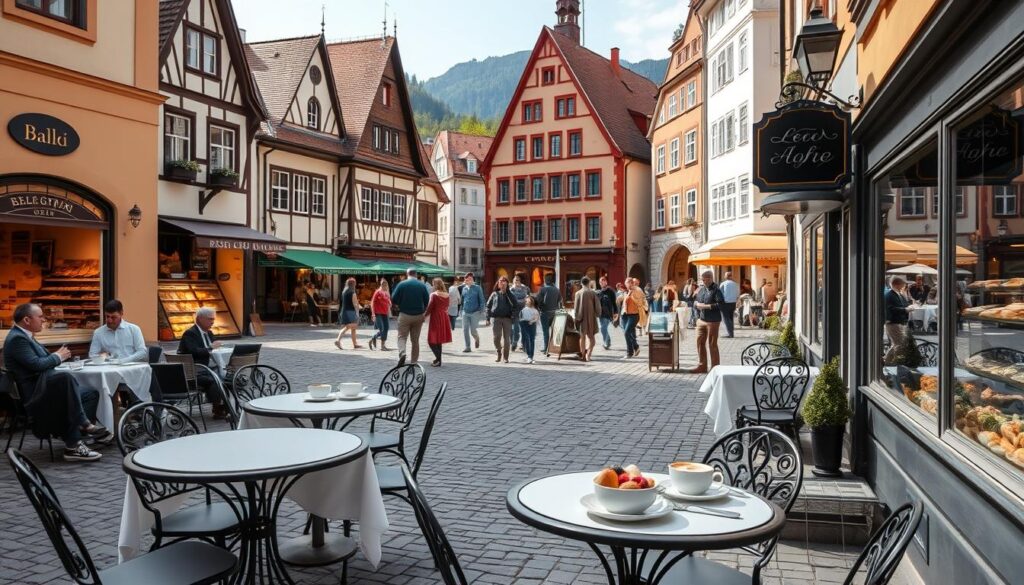
| Meal Type | Description | Typical Dishes |
|---|---|---|
| Breakfast | A simple meal to start the day | Bread, jam, cold meats, cheeses |
| Lunch | Traditionally the main meal | Tafelspitz, gulasch, knödel |
| Dinner | A lighter meal enjoyed in the evening | Palatschinken, seasonal vegetables |
Popular Austrian Beverages
Austrian beverages offer a delightful variety, reflecting the rich culinary traditions of the country. From renowned austrian wine selections to the charming coffee culture in austria, these drinks enhance the dining experience and showcase the nation’s local flavors and social rituals.
Austrian Wines: A Hidden Gem
Austria may not be the first country that comes to mind when discussing wine, yet its vineyards produce exceptional varieties. Featured prominently is Grüner Veltliner, a signature grape known for its lively citrus notes and versatility in pairing with dishes like Tafelspitz. The Wachau Valley stands out with approximately 60% of Austria’s vineyards, nurturing over one hundred wine producers. Riesling and Veltliner lead the way in common white wine varieties, offering refreshing flavors ideal for many culinary delights.
Coffee Culture in Austria
The coffee culture in austria boasts a rich history dating back to the 17th century. Elegant coffee houses serve more than just caffeine; they are vibrant social hubs where community members gather to enjoy robust blends like Wiener Melange. An impressive 92% of Austrians indulge in coffee daily, with a significant portion consumed at home. This loving relationship with coffee reveals itself in the intricate rituals surrounding each cup, making it a centerpiece of everyday life.

Embracing Regional Varieties in Austrian Cuisine
Austrian cuisine captivates with its rich regional diversity, each part of the country offering unique culinary traditions. Local flavors and dishes reflect the agricultural strengths and history of the regions, making every meal a journey through Austria’s vibrant culture. This section explores the tyrolean specialties, delightful viennese delicacies, and the unique styrian flavors that you simply cannot miss.
Tyrolean Specialties Worth Tasting
In Tyrol, hearty dishes often dominate the culinary scene. You will find traditional favorites like Tiroler Gröstl, a savory mix of leftover meats and potatoes, providing comfort and warmth against the mountain chill. This region emphasizes robust flavors and uses locally sourced ingredients, showcasing how regional austrian cuisine thrives on the ethos of farm-to-table dining.
Viennese Delicacies You Can’t Miss
Vienna is celebrated for its exquisite pastries and coffee culture. Indulge in the iconic Sachertorte, a moist chocolate cake layered with apricot jam, representing the luxurious side of viennese delicacies. The city’s cafés are not just places to enjoy sweet treats but are crucial social centers, emphasizing the importance of family and friendships. Other must-try Viennese specialties include the world-famous Wiener Schnitzel, offering a perfect balance of breaded veal and fresh lemon that elevates both taste and tradition.
Styrian Flavors to Explore
Traveling to Styria reveals a culinary landscape defined by the use of pumpkin seed oil, which adds distinctiveness to many local dishes. Renowned for its fresh produce, Styrian cuisine embraces seasonal ingredients, resulting in a celebration of flavors that links directly to the soil. Everything from hearty soups to vibrant salads exudes the essence of styrian flavors, making it a delightful destination for food enthusiasts.
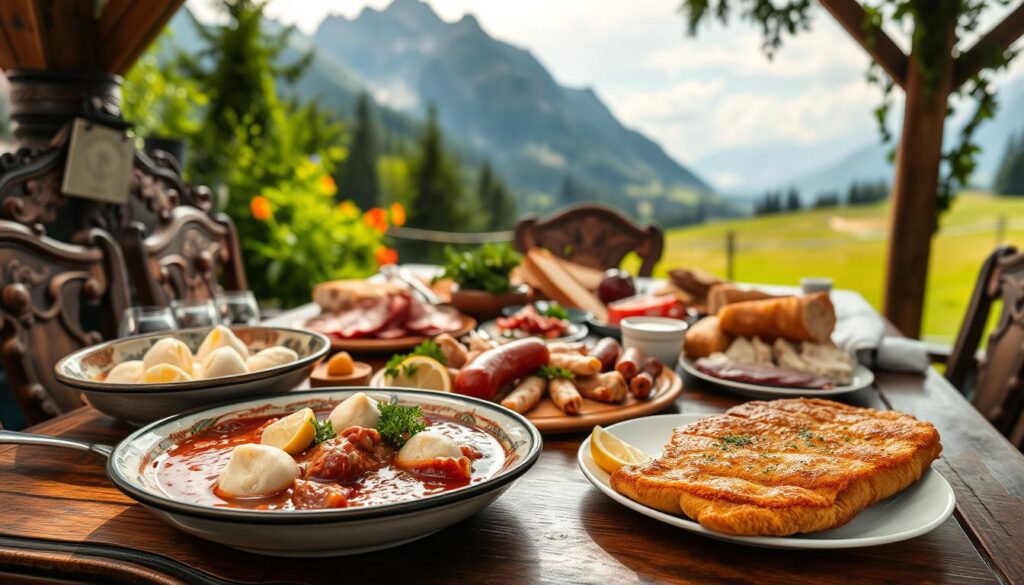
Cooking Techniques in Austrian Cuisine
Austrian cuisine showcases a variety of distinct cooking techniques that add depth and excitement to its well-loved dishes. Central to this culinary heritage are methods such as braising and the art of baking. These techniques not only enhance the flavors of hearty meals but also embody the spirit of Austrian baking traditions, where each pastry tells a story of dedication and skill.
The Art of Braising
Braising is a time-honored method in Austrian cooking, crucial for crafting flavorful dishes like Tafelspitz. This slow-cooking technique allows tough cuts of meat to become tender while absorbing the rich flavors of broth and vegetables. The result is not just food, but a warm, comforting experience often shared among family and friends. This method has roots deep in Austrian traditions, showcasing the importance of patience and time in developing culinary flavors.
Baking Traditions in Austria
Austrian baking traditions are revered and celebrated throughout the country. From the iconic Sachertorte, a chocolate cake rich in history dating back to 1832, to the delicate layers of Apfelstrudel, the meticulous crafting of pastries is a point of pride. Baking often transforms into a communal activity, with gatherings centered around sharing these delightful confections. Whether it’s the golden crust of a fresh pastry or the sweet aroma wafting through the kitchen, these experiences exemplify the passion and creativity inherent in cooking techniques in Austrian cuisine.

Vegetarian and Vegan Options in Austrian Cuisine
Austrian cuisine, known for its hearty meat dishes, is evolving to include a wide array of vegetarian and vegan options that cater to diverse palates. As the demand for plant-based diets continues to rise, restaurants across Austria are embracing creative ways to adapt traditional recipes. Vegetarian austrian cuisine is increasingly accessible and appealing, with numerous establishments offering hearty yet healthy meals that retain the essential flavors of the region.
Exploring Plant-Based Dishes
In Austria, you can find a growing number of places to enjoy delightful vegan options in austrian cuisine. For instance, ULRICH provides a large vegan breakfast plate along with a menu featuring various vegan salads, flatbreads, and gnocchi. Another popular spot, ERICH, serves vegan huevos rancheros and bowls that are packed with flavor. For a unique twist, Cafe Harvest offers an all-vegan brunch on weekends, including their celebrated vegan Wiener Schnitzel and scrambled tofu.
The vibrant city of Vienna is home to Veggiezz, which boasts five locations and an extensive selection of vegan offerings ranging from burgers to salads. The amusement park “Prater” also joins the trend with its Swiss House that features crispy fritters, appealing to wholesome eating habits. Veganista Ice Cream supports this movement by crafting 18 fresh ice cream flavors daily, ensuring that even dessert is guilt-free.
Healthy Twist on Classic Recipes
Many traditional Austrian dishes are being reimagined with healthier ingredients. Places like Gasthaus Zum Wohl blend classic Austrian flavors with vegan selections, such as spinach dumplings served with mushroom goulash. GustaV, Salzburg’s only entirely vegan restaurant, emerged successfully from a crowdfunding campaign, affirming the strong desire for healthy austrian recipes among diners. Other venues like Swing Kitchen and Voodies specialize in vegan fast food, indicating a growing market for such meals. Whether it’s a leisurely dinner or a fast bite, options abound to suit your diet without sacrificing taste.

Where to Experience Authentic Austrian Cuisine
When looking to savor authentic Austrian cuisine, you’ll find plenty of options across the United States. Numerous restaurants offer traditional dishes prepared with authentic methods, ensuring a genuine taste of Austria. Alongside these dining experiences, various food festivals celebrate Austrian culture and culinary delights, providing an excellent opportunity to engage with this rich heritage.
Best Austrian Restaurants in the U.S.
In your quest for the best Austrian restaurants, consider visiting establishments that bring a slice of Austria to the bustling food scene in the U.S. Notable spots include:
| Restaurant Name | Location | Specialty Dishes |
|---|---|---|
| Wratschko Gastwirtschaft | Vienna, VA | Wiener Schnitzel, Tafelspitz |
| Griechenbeisl | New York, NY | Pork Knuckle, Erdäpfelsalat |
| Figlmüller | Chicago, IL | Oversized Schnitzel, Kaspressknödel |
| Plachutta | Los Angeles, CA | Schweinsbraten, Schlutzkrapfen |
| Schnitzelwirt | San Francisco, CA | Large Schnitzels, Brettljause |
Food Festivals Celebrating Austrian Cuisine
Food festivals offer a vibrant way to explore authentic Austrian cuisine while enjoying a festive atmosphere. Such events often feature tastings of beloved dishes, live music, and cultural showcases. Key festivals to look out for include:
- Oktoberfest – Celebrate with traditional sausages, pretzels, and apple strudel.
- Austrian Wine Festival – Sample fine Austrian wines alongside delicious cheese and meat platters.
- Culinary Alps Festival – Focused on dishes from the Alpine regions, featuring Tiroler Gröstl and more.
- European Festival – Explore a variety of European cuisines, with a spotlight on Austrian specialties.
Engaging with the best Austrian restaurants and food festivals will truly enhance your experience of authentic Austrian cuisine. Each visit promises an unforgettable taste journey filled with tradition, flavor, and culinary artistry.
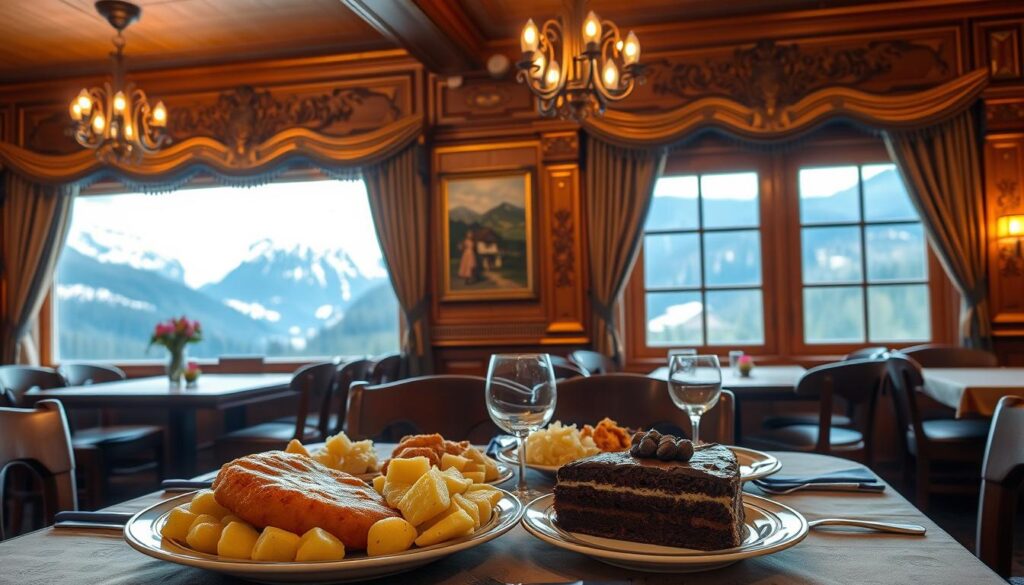
Tips for Cooking Austrian Dishes at Home
Cooking authentic Austrian dishes at home brings the rich culinary traditions of Austria right to your kitchen. By investing in the right kitchen tools for cooking and following simple, flavorful austrian food recipes, you can create delightful meals that reflect Austria’s heritage. From savory goulash to sweet strudel, the process of recreating these dishes can be both enjoyable and rewarding.
Essential Kitchen Tools You’ll Need
- Heavy skillet: Ideal for frying schnitzels and sautéing meats.
- Mixing bowls: Necessary for combining ingredients for dough and batter.
- Baking trays: Perfect for making traditional pastries and desserts like Apfelstrudel.
- Measuring cups and spoons: Ensures precise measurements in your austrian food recipes.
- Pasta maker: Useful for creating fresh noodles for dishes like Käsespätzle.
Step-by-Step Recipe Suggestions
When preparing to dive into the world of cooking austrian dishes, start with these simple steps:
- Choose a recipe: Begin with popular options like Wiener Schnitzel or Linzer Torte to familiarize yourself with techniques.
- Gather ingredients: Collect fresh, quality ingredients typical in Austrian cuisine, such as veal for schnitzels or apricots for desserts.
- Prepare your kitchen: Ensure your kitchen tools for cooking are ready and organized to make the process smooth.
- Follow the instructions: Pay attention to step-by-step guides for each dish, ensuring you replicate traditional flavors.
- Serve and enjoy: Share your creations with family or friends, embracing the importance of meals in Austrian culture.
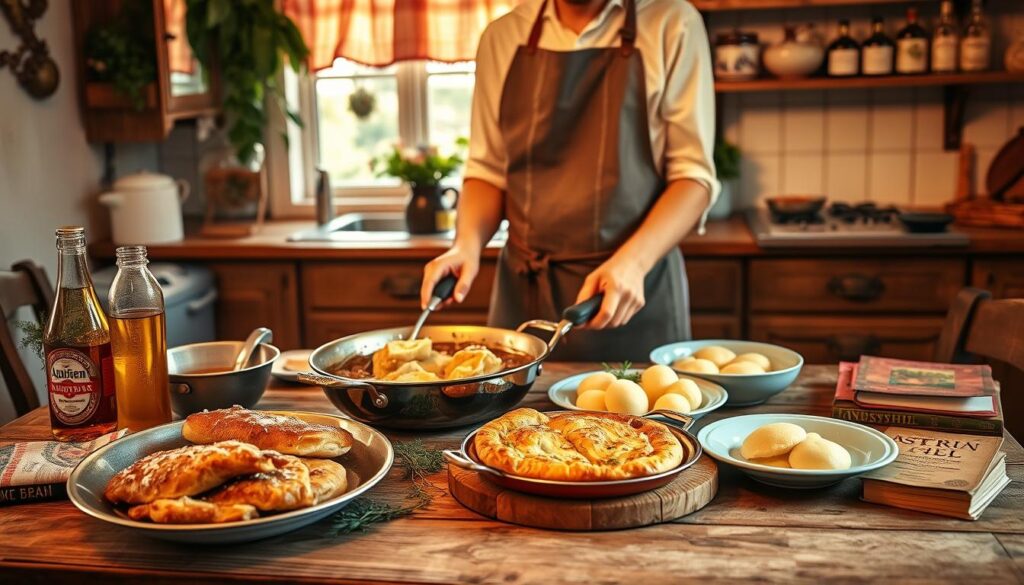
Exploring Modern Austrian Cuisine
Modern Austrian cuisine reflects a dynamic blend of tradition and innovation. With a focus on local ingredients, chefs are crafting fusion dishes that showcase familiar flavors while incorporating global culinary techniques. This evolution highlights the vibrant culinary landscape in Austria, where classics are reimagined without losing their essence.
Fusion Dishes: Traditional Meets Modern
Fusion dishes in modern Austrian cuisine offer an exciting twist on beloved classics. The use of seasonal ingredients enhances the flavors while maintaining authenticity. Popular dishes like Käsespätzle, Austria’s delightful answer to macaroni and cheese, have adapted to include contemporary ingredients, appealing to a broader audience. Chefs are experimenting with techniques that push traditional boundaries, creating meals that resonate with both locals and tourists alike. From the comfort of Tiroler Gröstl to the sweet satisfaction of Kaiserschmarrn, the fusion of flavors creates unforgettable dining experiences.
Influential Chefs Shaping the Scene
In the realm of modern Austrian cuisine, influential Austrian chefs play a crucial role in shaping the culinary identity of the country. Chefs are committed to promoting sustainable practices by sourcing organic and locally produced ingredients. This dedication is evident in the menus of Austria’s top restaurants, many of which hold Michelin stars. By reinterpreting classic dishes and introducing innovative cooking techniques, these chefs are elevating Austrian cuisine to new heights. As you explore the diverse food landscape, keep an eye on the creative minds behind the scenes, as they continue to redefine and expand the definition of modern Austrian cuisine.
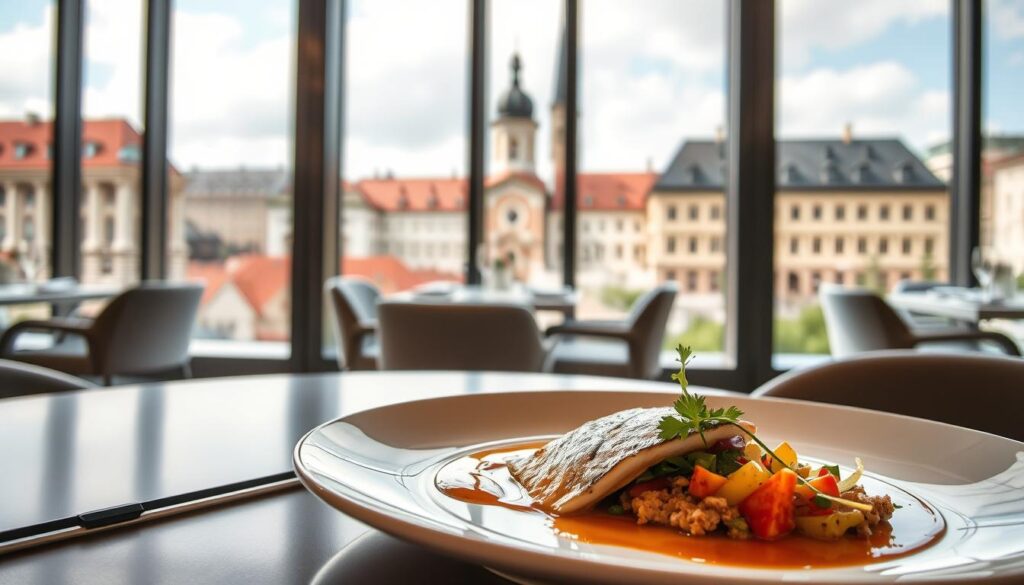
Sweet Treats: Desserts in Austrian Cuisine
Austrian desserts hold a special place in the hearts of many food lovers. Rich flavors and unique textures make these treats irresistible. Two standouts from this category are sachertorte and kaiserschmarrn, each offering a distinct experience that highlights Austria’s culinary flair.
Sachertorte: Chocolate Heaven
Sachertorte reigns as Austria’s most popular dessert, crafted in 1832. This luxurious chocolate cake consists of dense sponge layers, complemented by apricot jam and enveloped in a glossy dark chocolate icing. The balance of sweetness and richness makes sachertorte a perfect indulgence for chocolate lovers. When you visit an Austrian café, savoring a slice alongside a steaming cup of coffee enhances the experience, connecting you to the country’s rich cultural heritage.
Kaiserschmarrn: A Fluffy Delight
Kaiserschmarrn, affectionately known as “Emperor’s Mess,” exemplifies the playful nature of austrian desserts. This delightful dish features a light, fluffy pancake, torn into bite-sized pieces, and dusted with powdered sugar. Often served with a side of fruit compote, kaiserschmarrn invites you to experience a burst of flavors and textures with every forkful. Indulging in this dish offers not just a taste but also a glimpse into the joyful dining customs of Austria.
| Dessert | Main Ingredients | Special Features |
|---|---|---|
| Sachertorte | Chocolate sponge, apricot jam, dark chocolate icing | Rich and dense, a symbol of Austrian chocolate traditions |
| Kaiserschmarrn | Eggs, flour, milk, sugar | Fluffy, torn pieces served with fruit compote |
| Apfelstrudel | Flaky pastry, spiced apples, raisins, cinnamon | Austria’s most celebrated pastry, enjoyed warm |
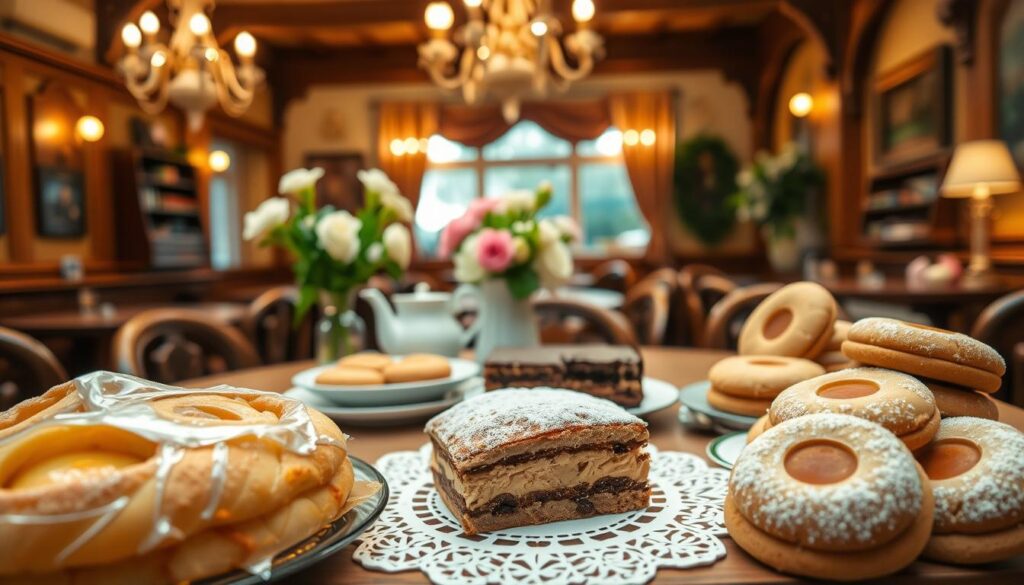
Seasonal Ingredients in Austrian Cooking
Austrian cuisine thrives on the use of seasonal ingredients, which greatly influences the flavors and nutritional value of dishes. Each season showcases a unique array of fresh produce in Austria that captures the essence of local agriculture. Cooking with seasonal Austrian ingredients not only enhances your meals but also supports sustainable practices by reducing transportation emissions and promoting local farmers.
Cooking with Fresh Produce
In March, the variety of seasonal fruits and vegetables available includes carrots, Brussels sprouts, garlic, pumpkin, and various types of cabbage. With a total of 16 seasonal fruits and vegetables on hand, you can get creative in the kitchen with around 30 recipe ideas. Incorporating these fresh ingredients into your cooking allows you to enjoy flavors at their peak. Techniques such as oven-baking and roasting highlight the natural goodness of seasonal produce, transforming simple vegetables like parsnips and beetroots into vibrant, delicious dishes.
Celebrating Harvest Festivals
Harvest festivals in Austria celebrate the bounty of local produce, bringing communities together to honor their agricultural heritage. These events often feature cooking competitions showcasing traditional recipes that utilize seasonal ingredients. They provide a platform for food enthusiasts to experience the best of what the land has to offer. Neighboring countries such as Hungary, Slovakia, and the Czech Republic add to the richness of this seasonal celebration, influencing culinary practices and creating a diverse food culture. Attending these festivals is a unique way to immerse yourself in the flavors and traditions of Austrian cooking.
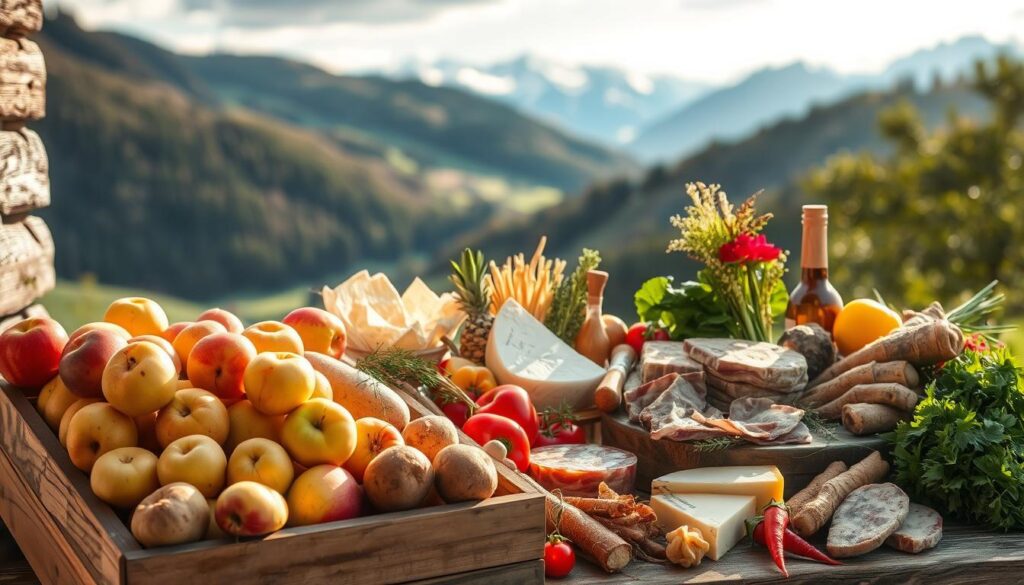
The Role of Cheese in Austrian Dishes
Cheese plays a vital role in cheese in austrian cuisine, offering a wide range of flavors and textures that complement many dishes. With approximately 450 varieties produced, you can explore different types, from hard mountain cheeses to creamy soft options. This abundance enriches traditional recipes, enhancing the overall dining experience.
Types of Austrian Cheese
Austria’s cheese production benefits from its unique geography, with around 75% of the land comprising rugged mountain terrain ideal for alpine dairy farming. The farmers, typically raising about 20 cows each, adhere to quality standards set by the European Union. This ensures the authenticity of alpine cheeses such as Bergkäse, a beloved hard cheese with a firm texture. Here are some popular types:
- Emmental: A Swiss-influenced cheese known for its mild flavor and holes.
- Bergkäse: Tangy and hard, perfect for grating over dishes.
- Topfen: A versatile quark used in both sweet and savory recipes.
- Blue Cheese: Rich and flavorful, often used in salads and spreads.
Regions such as Vorarlberg, known for its KäseStrasse, produce a delightful range of 60 varieties across 17 valley dairies. This offers a glimpse into the diverse landscape of austrian cheese.
Pairing Cheese with Your Meals
Creating delicious cheese pairings can elevate any meal. Many traditional Austrian dishes incorporate cheese as a key ingredient or accompaniment. For instance, Käsespätzle, a hearty dish, uses grated cheese to create creamy layers, while Käseknödel features dumplings stuffed with flavorful cheese. Here are some ideas for delightful pairings:
- Cheese and Bread: Pair cheese with freshly baked bread for casual dining.
- Cheese and Wine: Enjoy a glass of Austrian wine with your cheese selections.
- Cheese with Fresh Vegetables: Enhance salads with crumbled cheese for added texture.
- Cheese in Desserts: Incorporate Topfen in desserts like creamy cheesecakes.
Experimenting with various cheese pairings will deepen your appreciation for the rich flavors of austrian cheese and the culinary traditions they stem from.
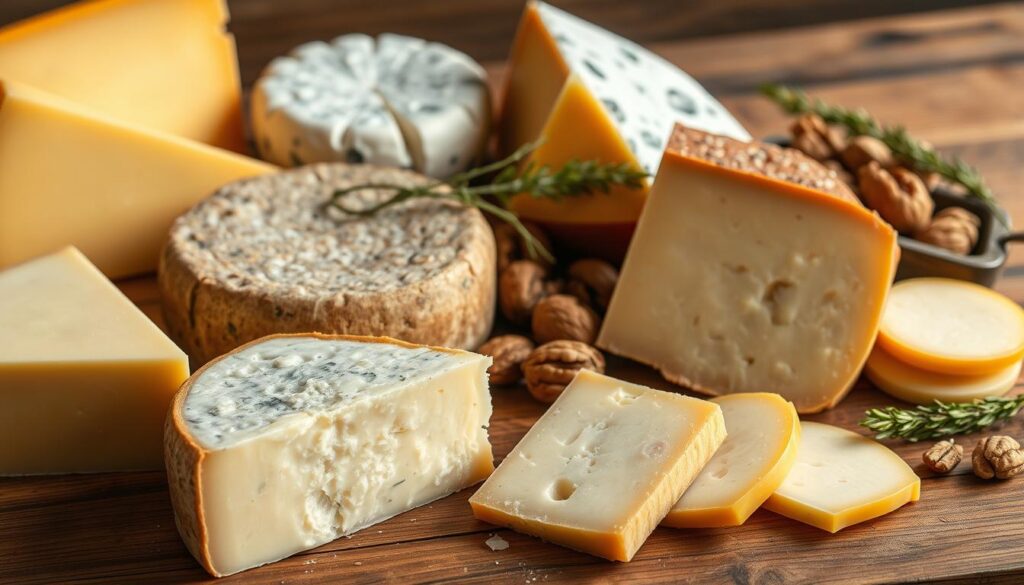
Discovering Austrian Cuisine Beyond Borders
Austrian cuisine has made significant strides beyond its homeland, leaving an enduring mark on the culinary landscape across Europe and beyond. The shared appreciation for rich pastries, comforting flavors, and robust dishes demonstrates the austrian culinary influence that has permeated numerous international kitchens. Many traditional practices and recipes have transformed into international austrian recipes, gaining popularity on global menus.
Influence on European Culinary Traditions
Countries neighboring Austria have embraced many facets of Austrian cooking. Dishes like Wiener schnitzel, a national staple, exemplify how a local delicacy can resonate across borders, while Austrian pastries such as Apfelstrudel and Sachertorte reflect a common love for desserts. This culinary exchange highlights a global appreciation of austrian cuisine found in various adaptations, making these recipes a favorite in homes and restaurants worldwide.
Austrian Recipes Worldwide
Many classic Austrian recipes have become renowned globally, showcasing the elegance and versatility of these traditional dishes. The table below highlights some of the most beloved Austrian recipes and their global adaptations:
| Dish | Global Adaptations | Notable Variants |
|---|---|---|
| Wiener Schnitzel | Found in various forms like Italian Cotoletta and Japanese Katsudon | Often paired with different sides such as potatoes or salads |
| Sachertorte | Variations like American Chocolate Cake or Swiss Chocolate Gateau | Gourmet interpretations featuring innovative flavors |
| Apfelstrudel | Popularized in cafes worldwide | Filled with diverse fruits or cream for modern tweaks |
| Tafelspitz | Similar dishes seen in Italian Bollito Misto | Served with various broths and sauces across cultures |
| Kaiserschmarrn | Embraced as a dessert in various Western cuisines | Fruity or savory fillings as contemporary twists |
From the hearty comfort of Goulash to the sweet indulgence of Linzer Torte, Austrian recipes resonate with culinary enthusiasts and home cooks alike. Each recipe tells a story of tradition, flavor, and the enduring legacy of Austrian culinary practices in a global context.
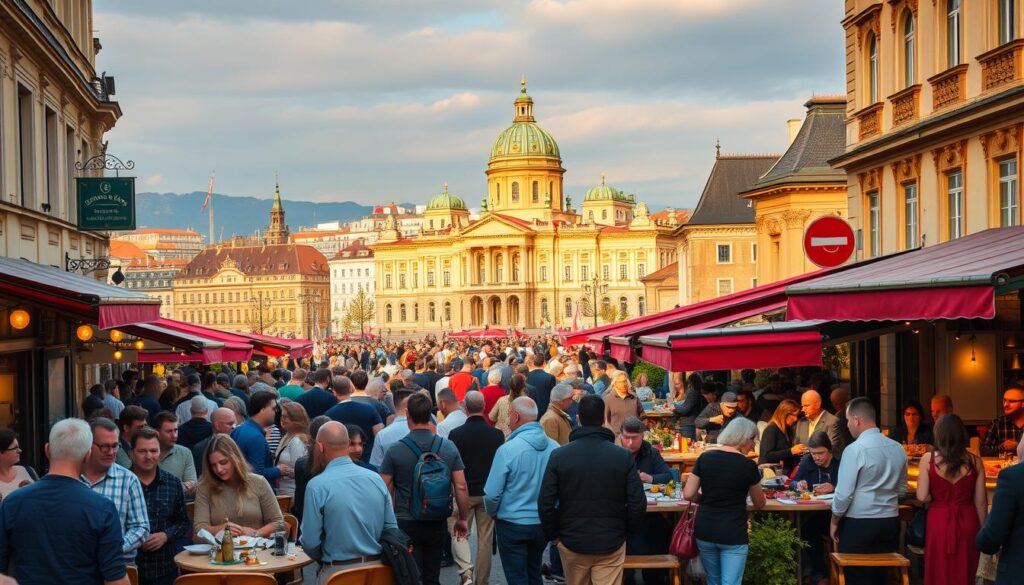
Conclusion: The Delight of Austrian Flavors
Bringing Austrian cuisine into your kitchen offers an exciting culinary journey that transports you to the heart of Central Europe. From the esteemed Wiener Schnitzel to the delightful Apfelstrudel, the variety of traditional and innovative recipes allows you to embrace Austrian cuisine like never before. By experimenting with these dishes, you can enjoy Austrian flavors that appeal to both established palates and adventurous eaters alike.
Embracing Austrian Cuisine in Your Kitchen
Cooking at home can be an enriching experience, especially when it involves beloved dishes crafted meticulously over generations. Consider hosting a dinner with friends featuring staples like goulash and Kaiserschmarrn, adding a personal twist that reflects your taste. As you dive into these recipes, you’ll discover how easy it is to embrace Austrian cuisine and create memorable meals that nourish both the body and spirit.
Whether it’s a cozy family meal or an exciting gathering with friends, Austrian flavors invite you to gather around the table. So why not embrace the opportunity to cook at home? Explore the rich culinary heritage by incorporating local wines from Heuriger taverns or sample desserts like the iconic Sachertorte, ensuring every bite tells a story of Austria’s charming gastronomic landscape.
